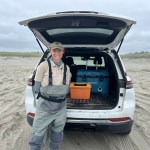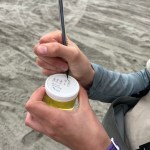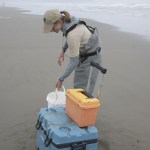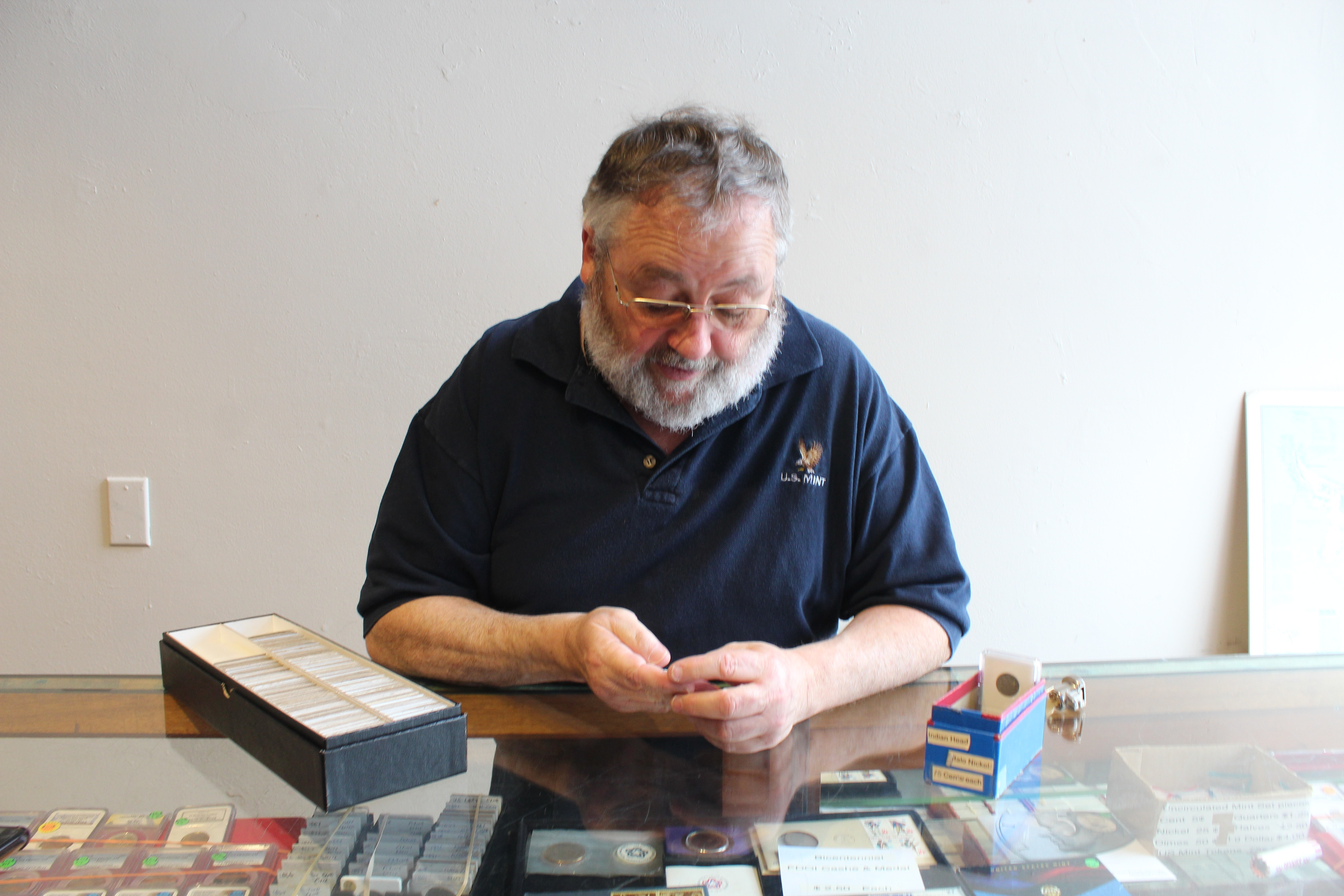An ‘early alarm system’ can warn of harmful toxins
Published 2:57 pm Wednesday, July 23, 2025



Scientists monitor algal blooms with human health in mind
When Becca Crawford goes out to collect water samples from beaches along Oregon’s North Coast, she brings a cooler, a pair of waders and a five-gallon bucket.
On a recent overcast afternoon in July, she pulled up to Sunset Beach outside of Gearhart in a white Jeep Grand Cherokee, navigating the ruts in the loose sand before parking a few yards away from the incoming tide. Then, slipping out of her rubber boots and into the waders, she ventured into the chilly calf-deep waves.
Trending
As Crawford knows, each bucket of seawater she collects can contain thousands of cells of phytoplankton — tiny, invisible algae that can have major impacts on human health.
Crawford is a marine phytoplankton specialist with the Oregon Department of Fish and Wildlife, and she’s part of a network of researchers and volunteers working to track harmful algal blooms along the Pacific coast. Now, for the first time ever, that work has been slated to receive state funding through the Oregon Legislature, opening up a new chapter for monitoring efforts.
From the ocean to the lab
Crawford will be quick to tell you that not all phytoplankton are dangerous. In fact, many are extremely beneficial. But some phytoplankton can produce harmful toxins — and in high enough concentrations, those toxins can accumulate in the meat of shellfish and make people sick.
In May 2024, the Oregon Coast witnessed an outbreak of more than 30 cases of paralytic shellfish poisoning, sending some people to the hospital and prompting shellfish harvesting closures up and down the Washington and Oregon coasts.
“I think that event just changed the nature of how people looked at harmful algal blooms on the west coast,” said Matt Hunter, ODFW’s shellfish project leader.
Trending
Collecting water samples and monitoring for those toxin-producing algae can play an important role in sounding the alarm for similar future events. In Oregon, Crawford and a team of volunteers and partners with the Confederated Tribes of Coos, Lower Umpqua and Siuslaw Indians work together to take samples from eight different beaches along the coast, spanning from Gold Beach to Warrenton. Meanwhile, in Washington, the Olympic Region Harmful Algal Blooms Partnership and local tribes take on similar work.
Together, their samples are used to provide real-time data and forecasts online through the Pacific Northwest HAB Bulletin, a communication tool that provides an early warning of HABs to coastal managers.
“It would not be possible without these partnerships and these other groups to get the full coverage of the coast that we are able to get,” Crawford said.
On a typical day of sampling, Crawford visits five sites: Cape Meares, Tolovana Park, Seaside, Sunset Beach and Fort Stevens State Park. At each site, she’ll use the bucket of water she collects to fill three different containers.
The first container — a small, 125-milliliter glass jar — is for a “whole water sample” intended to represent the water as a whole across the surf zone. The second container — a 2-liter bottle with a lime green lid — is used to test for toxins. The third — another 125-milliliter glass jar — is used for water that’s gone through a filter to help concentrate phytoplankton cells.
Crawford then brings the containers back to the lab and looks at a tiny portion of the whole water sample under a microscope, counting each harmful algae cell she sees using a clicker to estimate the total number of cells per liter. She also looks at the more concentrated sample, taking note of whether she sees any additional species.
A wild card
When scientists talk about harmful algal blooms, they’re typically looking for a couple of key species of phytoplankton.
Pseudo-nitzschia is an algae that produces domoic acid, which can cause amnesic shellfish poisoning. Under the right circumstances, it can proliferate very quickly, causing large blooms — and if those blooms are producing high levels of domoic acid, they’re considered harmful. It all comes down to a mix of sunlight, temperature and nutrient availability.
“It’s kind of like the dominoes game,” said Vera Trainer, director of the Olympic Region Harmful Algal Blooms Partnership. “You need all those factors to come into play in order for there to be a big bloom. It’s not just one thing. It’s not just warming — it’s, you know, a sequence of events in the coastal ocean that make conditions favorable for these harmful species. But once the conditions are favorable, they can thrive.”
Trainer has been working with phytoplankton for decades, and at this point, she said scientists have a decent understanding of Pseudo-nitzschia.
Not all Pseudo-nitzschia produce the same levels of toxins — or any at all, necessarily — so when scientists like Crawford count them beyond a certain threshold in their samples, they use an enzyme-linked immunosorbent assay, or ELISA, test to see how much particulate domoic acid is actually in the water.
“That system is working really well,” Trainer said. “It helps provide an early warning to our health department and also the Oregon Department of Fish and Wildlife.”
But another species of phytoplankton, called Alexandrium, can be harder to track.
“This particular organism, Alexandrium, produces a suite of toxins — like many different forms that the antibody doesn’t recognize equally well,” Trainer said. “So it’s really complicated to make a kit that will work well, and basically, with Alexandrium, any number of cells over just a couple in the microscope could be dangerous.”
Alexandrium produces saxitoxin, the neurotoxin responsible for last year’s paralytic shellfish poisoning event. To date, there still isn’t a standard ELISA test for saxitoxin — and to make matters more complicated, Alexandrium can swim up and down the water column, making it harder to know whether it’s present just from a surface water sample. It also tends to have slower growth rates.
“A wild card is a good way to put it, because loosely, very generally, the way that we’re monitoring all of these harmful algae is just going out, collecting samples and counting them in a sample. And when we see a lot, that’s kind of when we can put out the warning that something might be a problem, or do further tests to check for toxins, and we have very specific thresholds for Pseudo-nitzschia,” Crawford said. “We don’t have that for Alexandrium — they can be really tricky. Sometimes you’ll see them in a sample and there won’t be any indication that they’re producing a significant amount of toxins, and other times, you won’t see them at all in a sample, and all of a sudden, we might see an increase in toxins and in certain shellfish.”
A long time coming
Looking back at the data, Crawford said it’s clear just how effective harmful algal bloom monitoring can be. If she sees high levels of Pseudo-nitzschia or Alexandrium in her samples, she can give a heads-up to the Oregon Department of Agriculture, which typically tests shellfish for toxins every other week — playing an important role in protecting human health and informing commercial growers and harvesters.
“If you were just relying on the biotoxin data, you would have no reason to expect that in a couple weeks we might see an increase in accumulation of toxin in the shellfish,” Crawford said. “But by knowing that there had been this shift in the phytoplankton community and that these cells were toxic, we could be prepared and know ahead of time what was to come. And that’s really the purpose of the program, is to provide this early alarm system.”
But it’s also clear what’s at stake when there isn’t a monitoring program in place.
Unlike its neighbors to the north and south, the Oregon Department of Fish and Wildlife has historically never received state funding for harmful algal bloom monitoring. Instead, it relied on a patchwork of grants, starting with a small grant in 2005 and later receiving two different federal grants from the National Oceanic and Atmospheric Administration’s National Centers for Coastal Ocean Science, Hunter said.
ODFW’s monitoring work wouldn’t be possible without NOAA’s support. Between the two federal grants, however, the agency saw a gap in funding.
“And that’s just missing data,” Crawford said. “The whole point of this program is we’re eventually hoping to be able to use our historical data sets to continuously inform us about how we might expect things to change in the future. And so, making sure that there’s always funding for the program is kind of the only way to continue that.”
It seems more sustainable funding is right around the corner, though: lawmakers recently approved a first-ever round of state funding for a full-time ODFW phytoplankton specialist and two seasonal staff — more dedicated harmful algal bloom staff than the agency has ever had. Gov. Tina Kotek has also signed off.
Hunter said it’s been a long time coming.
“It’ll allow us to network more with our neighboring states, whereas when you just have a very small grant-funded program, you don’t really have the funding or the logistics to be able to do that. You’ve just kind of got your nose to the ground, just doing the bare minimum that you can do,” Hunter said. “But this way we’ll have a greater opportunity to be able to participate in these other … ventures.”
Looking ahead, Crawford will continue her weekly routine of pulling up to the beach, putting on the waders and venturing into the surf zone with a five-gallon bucket.
By this time next year, she could have a couple extra sets of hands helping her provide that early warning system — one little jar at a time.
Editor’s note: Olivia Palmer and Becca Crawford are friends through the Astoria Run Club. To the editor’s knowledge, this relationship has not influenced the decision to include this article or the content presented within it. The Astorian is committed to maintaining journalistic integrity and providing unbiased information to readers.












